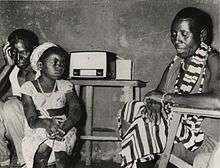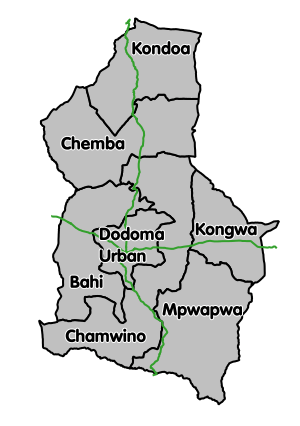Dodoma Region
| Dodoma Region Mkoa wa Dodoma (Swahili) | |
|---|---|
| Region | |
 | |
| Country | Tanzania |
| Zone | Central |
| Capital | Dodoma |
| Area | |
| • Total | 41,311 km2 (15,950 sq mi) |
| Population (2012) | |
| • Total | 2,083,588 |
| • Density | 50/km2 (130/sq mi) |
| Time zone | EAT (UTC+3) |
| Postcode | 41xxx |
| Area code(s) | 026 |
| Website |
dodoma |
Dodoma Region is one of Tanzania's 30 administrative regions. The regional capital is the city of Dodoma. According to the 2012 national census, the region had a population of 2,083,588, which was lower than the pre-census projection of 2,214,657.[1] For 2002-2012, the region's 2.1 percent average annual population growth rate was the twentieth highest in the country. It was also the seventeenth most densely populated region with 50 people per square kilometer.[1] The main tribes of the region are the Gogo, the Warangi, and the Wasandawi; Dodoma means "sunk" in the Gogo language.[2]
History

The city of Dodoma, the largest city and capital of the region, originally began as a small Gogo village in the early 19th century, consisting of several traditional tembe houses.[3] The city was formally established in 1907 by German colonists during construction of the Tanzanian central railway. The region has a long history of famine and economic difficulties. Along with Kondoa and Singida it was struck hard by the famine of the 1910s. One report by a British officer in Dodoma in December 1916 reported that "The whole District has been ransacked for cattle". The Germans had killed 26,000 animals, and the British 5,659.[4] The problems continued throughout 1917, and in November 1917 drought turned it into a crisis. Some 30,000, about 1 in 5 of the population of the district at the time died. Thousands of people emigrated, and others sold starving cattle for just a shilling at the market in Dodoma. Smallpox was prevalent, and a Spanish influenza epidemic killed an estimated 50,000–80,000 in Tanganyika between 1918 and 1920.[4]
When the British took over the country, they favoured Dar es Salaam and Arusha, and the area began to decline in importance. The importance declined further in the 1960s when the Tanzam Highway was built by the Chinese, connecting Dar es Salaam to Morogoro and Iringa.[3] On 9 December 1961, Tanganyika won independence from Britain, and Dodoma remained the capital of the Central Province. In 1963, the provinces of the new nation were divided into smaller administrative units and were renamed regions, and the Dodoma Region was established.[2] However, in 1973, the Tanzanian government announced that the capital would be moved from Dar es Salaam to a more central location to better serve the needs of the people. Dodoma was selected for this purpose, as it was an already established town at a major crossroads with an agreeable climate and scope for development.[5] The same year, the Tanzanian government launched a national soil conservation programme, known as the Dodoma Soil Conservation Programme, to improve soil fertility and productivity in the worst affected areas of the region.[6]
Geography
The Dodoma Region lies in the heart of Tanzania in the eastern-central part of the country, the main city being about 300 miles (480 km) from the coast.[7] The region, which is primarily semi-arid, covers an area of 41,311 square kilometres (15,950 sq mi),[8] making it slightly larger than Switzerland (41,284 square kilometres (15,940 sq mi)).[9] The region is bordered by the Manyara Region to the north, the Singida Region to the west, the Iringa Region to the south, and the Morogoro Region to the southeast. The Wami River Sub-Basin "extends from the semi-arid Dodoma region to the humid inland swamps in the Morogoro region to Saadani Village in the coastal Bagamoyo district",[10] and the Kikuyu River also flows through the region, flowing near the city of Dodoma itself.[3]
The region produces beans, seeds, grain, peanuts, coffee, tea, and tobacco.[7] Cattle are also raised and marketed.
Districts
The region is administratively divided into seven districts:[11]
| Districts of Dodoma Region | ||||||
|---|---|---|---|---|---|---|
| Map | District | Population (2012) | Area km² | |||
 |
Bahi | 221,645 | ||||
| Chamwino | 330,543 | |||||
| Chemba | 235,711 | |||||
| Dodoma | 410,956 | 2,576 | ||||
| Kondoa | 269,704 | 13,210 | ||||
| Kongwa | 309,973 | 4,041 | ||||
| Mpwapwa | 305,056 | 7,479 | ||||
| Total | 2,083,588 | 41,310 | ||||
Education
Dodoma is the centre of educational activity in the region, with two universities as of 2009. The University of Dodoma is situated at a 6,000 hectare site in the Chimwaga area about 8 kilometres (5.0 mi) east of downtown Dodoma.[12] Established in 2007, in coordination with Tanzania’s Development Vision 2025,[13] the University of Dodoma is expected to have some 50,000 students when fully functional.[12] more than double the size of the University of Dar es Salaam. The university had an expected enrollment of 40,000 in 2012, five years after opening.[2] The other university is the St. John's University of Tanzania.[2]
Transport
Roads
Dodoma region is connected by paved trunk road (T3) that starts in Dar es Salaam on the coast, passes through Morogoro, Dodoma, and Singida, and ends at the Rwanda border. In 2016, a paved trunk road (T5) to Iringa was opened.[14] The trunk road (T5) to Babati in Manyara Region was still underway as of 2016.[15] Dodoma lies along the Great North Road, a major infrastructural network of Africa which connects Cairo to Cape Town.[2]
Railways
The central railway of Tanzania passes through the city of Dodoma.[16]
Airports
The region is served by Dodoma Airport. In the mid 1970s, it was reported that the airport was to be rebuilt in a new location, 10 kilometres north of Dodoma.[17]
References
- 1 2 "Population Distribution by Administrative Units, United Republic of Tanzania, 2013" (PDF). Nbs.go.tz. pp. 2–6. Retrieved 18 September 2014.
- 1 2 3 4 5 Lawrence, David (12 March 2009). Tanzania and Its People. Intercontinental Books. p. 21. ISBN 978-1-4414-8692-9.
- 1 2 3 Finke, Jens (2003). Tanzania. Rough Guides. p. 244. ISBN 978-1-85828-783-6.
- 1 2 A Modern History of Tanganyika. Cambridge University Press. 10 May 1979. pp. 269–70. ISBN 978-0-521-29611-3.
- ↑ Aloysius C. Mosha. "The planning of the new capital of Tanzania: Dodoma, an unfulfilled dream" (PDF). University of Botswana. Retrieved 18 September 2014.
- ↑ Kategile, Jackson A.; Mubi, S. (1993). Future of Livestock Industries in East and Southern Africa: Proceedings of the Workshop Held at Kadoma Ranch Hotel, Zimbabwe, 20–23 July 1992. ILRI (aka ILCA and ILRAD). p. 201. ISBN 978-92-9053-271-2.
- 1 2 The New Encyclopaedia Britannica. Encyclopaedia Britannica. 2003. p. 148. ISBN 978-0-85229-961-6.
- ↑ "Statistical Abstract 2011, Tanzania National Bureau of Statistics". Nbs.g.tz. Retrieved 18 September 2014.
- ↑ "Total surface area as of 19 January 2007". United Nations Statistics Division. Retrieved 23 September 2014.
- ↑ James Ngana; Florence Mahay; Katharine Cross. Wami basin: a situation analysis. IUCN. p. 3. ISBN 978-2-8317-1226-0.
- ↑ "Tanzania". Geohive.com. Retrieved 18 September 2014.
- 1 2 Sengiyumva, Gasirigwa (29 July 2010). "University of Dodoma:Embracing knowledge for country's development". Daily News. Dar es Salaam, Tanzania. Retrieved 18 September 2014.
- ↑ 'Be a nation with high quality of education at all levels' "The Tanzania Development Vision 2025". 2000.
- ↑ "New roads to boost local economies in Dodoma-Iringa". Daily News. Retrieved 17 June 2016.
- ↑ "Dodoma Roads Network" (PDF). Tanroads. Retrieved 17 June 2016.
- ↑ "Railways Network". Tanzania Railways Limited. Retrieved 17 June 2016.
- ↑ National Capital Master Plan, Dodoma, Tanzania. The Associates. 1976. p. 35.
External links
Coordinates: 6°00′S 36°00′E / 6.000°S 36.000°E